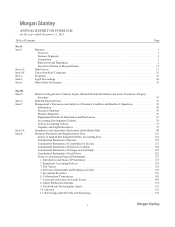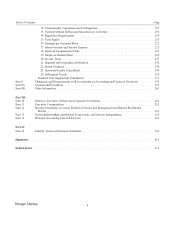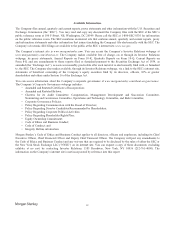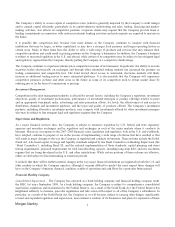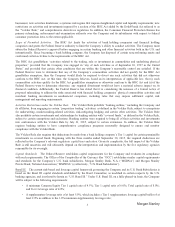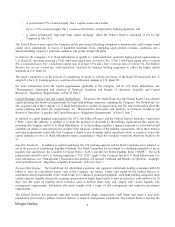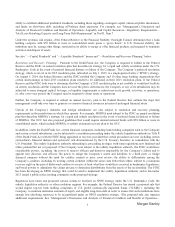Morgan Stanley 2015 Annual Report Download - page 10
Download and view the complete annual report
Please find page 10 of the 2015 Morgan Stanley annual report below. You can navigate through the pages in the report by either clicking on the pages listed below, or by using the keyword search tool below to find specific information within the annual report.
• A greater than 2.5% Common Equity Tier 1 capital conservation buffer;
• Up to a 2.5% Common Equity Tier 1 countercyclical buffer, if deployed by banking regulators; and
• A global systemically important bank capital surcharge, which the Federal Reserve calculated at 3% for the
Company in July 2015.
The Federal Reserve may require the Company and its peer financial holding companies to maintain risk- and leverage-based
capital ratios substantially in excess of mandated minimum levels, depending upon general economic conditions and a
financial holding company’s particular condition, risk profile and growth plans.
In order for the Company’s U.S. Bank Subsidiaries to qualify as “well-capitalized” under the higher capital requirements in
U.S. Basel III, they must maintain a Total risk-based capital ratio of at least 10%, a Tier 1 risk-based capital ratio of at least
8%, a Common Equity Tier 1 risk-based capital ratio of at least 6.5% and a Tier 1 leverage ratio of at least 5%. The Federal
Reserve has not yet revised the “well-capitalized” standard for financial holding companies to reflect the higher capital
standards in U.S. Basel III.
The Basel Committee is in the process of considering revisions to various provisions of the Basel III framework that, if
adopted by the U.S. banking agencies, could result in substantial changes to U.S. Basel III.
For more information about the capital requirements applicable to the Company and its U.S. Bank Subsidiaries, see
“Management’s Discussion and Analysis of Financial Condition and Results of Operation—Liquidity and Capital
Resources—Regulatory Requirements” in Part II, Item 7.
Capital Planning, Stress Tests and Capital Distributions. Pursuant to the Dodd-Frank Act, the Federal Reserve has adopted
capital planning and stress test requirements for large bank holding companies, including the Company. The Dodd-Frank Act
also requires each of the Company’s U.S. Bank Subsidiaries to conduct an annual stress test. For more information about the
capital planning and stress test requirements, see “Management’s Discussion and Analysis of Financial Condition and
Results of Operation—Liquidity and Capital Resources—Regulatory Requirements” in Part II, Item 7.
In addition to capital planning requirements, the OCC, the Federal Reserve and the Federal Deposit Insurance Corporation
(“FDIC”) have the authority to prohibit or to limit the payment of dividends by the banking organizations they supervise,
including the Company and its U.S. Bank Subsidiaries, if, in the banking regulator’s opinion, payment of a dividend would
constitute an unsafe or unsound practice in light of the financial condition of the banking organization. All of these policies
and other requirements could affect the Company’s ability to pay dividends and/or repurchase stock, or require it to provide
capital assistance to its U.S. Bank Subsidiaries under circumstances which the Company would not otherwise decide to do
so.
Liquidity Standards. In addition to capital regulations, the U.S. banking agencies and the Basel Committee have adopted, or
are in the process of considering, liquidity standards. The Basel Committee has developed two standards intended for use in
liquidity risk supervision, the Liquidity Coverage Ratio (“LCR”) and the Net Stable Funding Ratio (“NSFR”). The LCR
requirements issued by the U.S. banking regulators (“U.S. LCR”) apply to the Company and its U.S. Bank Subsidiaries. For
more information, see “Management’s Discussion and Analysis of Financial Condition and Results of Operation—Liquidity
and Capital Resources—Regulatory Liquidity Framework” in Part II, Item 7.
Systemic Risk Regime. The Dodd-Frank Act established a systemic risk regime to which bank holding companies with $50
billion or more in consolidated assets, such as the Company, are subject. Under rules issued by the Federal Reserve to
implement certain requirements of the Dodd-Frank Act’s enhanced prudential standards, such bank holding companies must
conduct internal liquidity stress tests, maintain unencumbered highly liquid assets to meet projected net cash outflows for 30
days over the range of liquidity stress scenarios used in internal stress tests, and comply with various liquidity risk
management requirements. Institutions also must comply with a range of risk management and corporate governance
requirements.
The Federal Reserve has proposed rules that would establish single counterparty credit limits and create a new early
remediation framework to address financial distress or material management weaknesses. The Federal Reserve also has the
4



